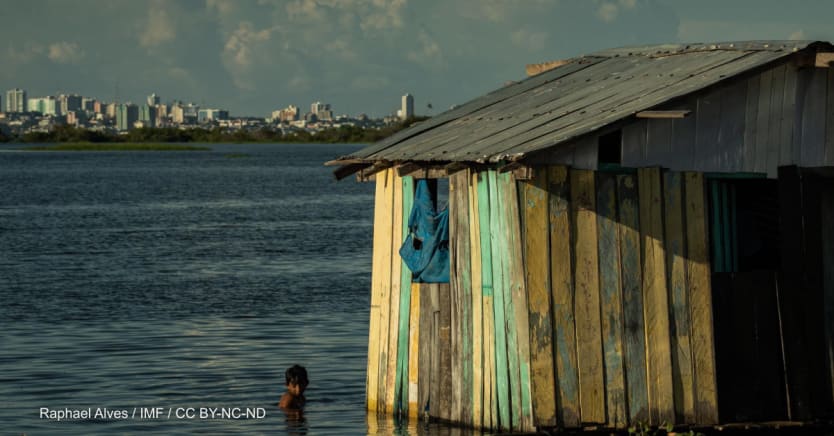
Philanthropy advocates in the U.S. and Europe have issued a new guide encouraging funders to include climate justice — and not just climate change — in their grant-making priorities to help communities disproportionately impacted by flooding, extreme heat, and other adverse weather effects.
Foundations should consider integrating climate justice into their core values and funding strategies, according to guidelines released Wednesday by Candid, a U.S.-based philanthropic research organization, and Ariadne, a network of European foundations and funders.
“As more and more foundations wake up to the urgency of addressing the climate crisis and commit themselves to investing more in climate work, we hope that climate justice will become a priority not just for human rights funders but for a wide range of foundations that want to tackle the root causes of climate change,” Ariadne Director Julie Broome wrote in the guide’s foreword.
New climate pledges of “staggering amounts” are “seemingly made every week,” yet whether the funding will be distributed equitably is unclear, according to the guide. Often, climate solutions that receive the most money from philanthropists are generated by organizations in the global north with majority-white leadership and staffs, it said.
These groups have tended to focus on technical solutions — such as installing costly solar panels — that often perpetuate or exacerbate inequities, the guide said. Meanwhile, solutions developed by the communities most impacted by the climate crisis are often ignored, it added.
Thirty funders, practitioners, and field leaders — including donor advisers — from the United States, Asia, Africa, Europe, and Latin America were interviewed for the guide, which calls for grant-makers to direct more resources to organizations in the global south and front-line communities in the global north, among other recommendations.
Climate justice is not concretely defined in the document, but its authors refer to a commonly held understanding that it is an approach focusing on the root causes of climate change and its relationship to historical systems of oppression.
The guide encourages foundation boards and executive leaders to establish institutional commitments to climate justice. One way to do this would be to create a commitment that is aligned with institutional funding and values, said Janet Camarena, a senior director of learning experience at Candid.
Many foundations have already done that with health equity in response to the COVID-19 pandemic, she said, as well as with racial and social equity amid a national reckoning on race in the U.S. after the murder of George Floyd, a Black man who died in police custody in 2020.
“From interviews where we’ve talked to foundations that have made this leap into climate justice, it all started with that kind of reflection into these values,” she said, adding that foundations have to decide if their values are “just words on our website or are we actually going to lean into them and live them.”
The Open Society Foundations and the Bezos Earth Fund are among the organizations with commitments to climate justice. Bezos Earth Fund has pledged $443 million to environmental and climate justice groups and recently added an adviser for “resilience and communities” to its senior leadership. Last year OSF hired its first climate justice director, tasked with integrating climate justice into the organization’s human rights and democracy-building work.
Still, funding for climate philanthropy, and specifically for climate change mitigation, isn’t increasing fast enough, according to recent data from ClimateWorks Foundation, a nonprofit research and grant-making organization. Less than 2% of global giving went to climate change mitigation in 2020, the group said.
“We hope that climate justice will become a priority not just for human rights funders but for a wide range of foundations that want to tackle the root causes of climate change.”
— Julie Broome, director, AriadneThe new guide also encourages funders to support the work of so-called intermediary organizations that can help grassroots groups learn where funding and other resources are most needed. They also should consider providing more multiyear grants with an emphasis on “core support” for an organization’s operations, among other things, it said.
The guide is careful not to be too prescriptive with its recommendations, according to Camarena, so each foundation and grant-maker can approach it in different ways based on their own resources. In some cases, foundations might hire additional staffers to steer their climate justice efforts, as OSF and the Bezos Earth Fund did, she said. Smaller foundations, with less capacity to add personnel, might be unable to make far-reaching changes or open an entirely new office focused on climate justice, she added.
Camarena highlighted the U.S.-based McKnight Foundation, which began to shift its climate work away from clean energy decarbonization goals and toward equitable climate solutions. The foundation, which was included as a case study in the guide, integrated climate justice into its “strengthening democratic participation” portfolio and hired its first joint program officer to work across its climate and communities portfolios, Camarena said.
“What works for one foundation won’t identically work in another,” she said. “But the reason we collect the case studies is because peer funders will listen to other peers, and they want to inform their strategies based on what’s worked for other funders. Invariably they will adapt it so that it makes sense for their local cultural staffing and scale.”








